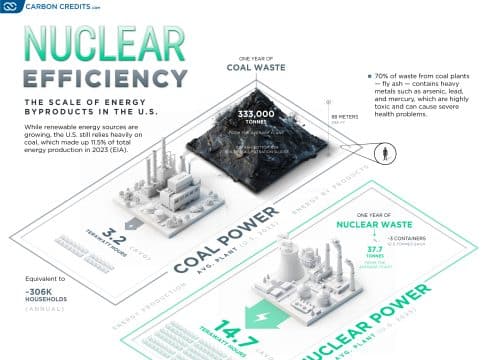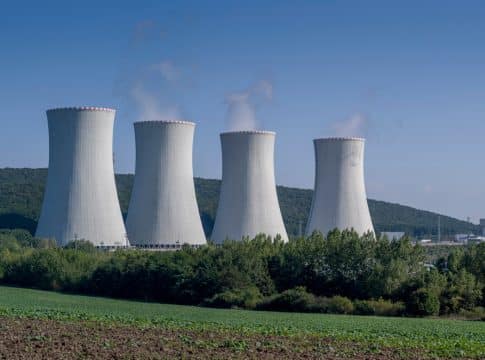Westinghouse is Pioneering Nuclear Microreactor for Remote Energy Needs
Westinghouse Electric Company has successfully finished the front-end engineering and experiment design (FEEED) phase for its eVinci microreactor prototype. This phase is part of preparations for testing at the Idaho National Laboratory (INL), scheduled as early as 2026. The eVinci microreactor is one of three innovative designs selected for evaluation at the world’s first nuclear microreactor test bed.
The FEEED phase is critical for developers like Westinghouse to plan and design the fabrication, construction, and potential testing of the reactor at the DOME test bed. The test bed is operated by the National Reactor Innovation Center (NRIC), a U.S. Department of Energy initiative.
A MESSAGE FROM URANIUM ROYALY CORP.
The First and Only Pure Play Uranium Royalty Company
Uranium Royalty Corp is the first company to apply the successful royalty and streaming business model exclusively to the uranium sector.
With interests in advanced, permitted and producing uranium projects, the company is well positioned as a capital provider to meet the growing need for uranium as fuel for carbon free, nuclear energy.
Discover first mover pure-play uranium royalty exposure >>
[ Disseminated on behalf of Uranium Royalty Corp.] NASDAQ: UROY | TSX: URC
What Are Nuclear Microreactors?
Nuclear is getting smaller and smaller. Nuclear microreactors are a prime example.
Several microreactor designs are being developed in the U.S. These small reactors are portable, fitting on a truck, and could address energy needs in remote locations, both commercial and residential, as well as military bases.
Microreactors are distinguished by 3 main features rather than their fuel or coolant, according to U.S. DOE’s Office of Nuclear Energy:
Factory Fabrication: All components are pre-assembled in a factory and shipped to the site, reducing construction challenges and capital costs, and allowing quick deployment.
Transportability: Their small size allows easy transportation via truck, ship, airplane, or train, making deployment versatile.
Self-Adjustment: They are designed to automatically adjust operations with minimal operator involvement, using passive safety systems to prevent overheating or meltdowns.
Graphic from the US DOE’s Office of Nuclear Energy
Westinghouse’s completion of its prototype microreactor’s FEEED process moves the project a step closer to the testing and commercialization phase. The process involves creating a detailed schedule, budget, and design for the experiment, along with a preliminary safety report to ensure safe testing. This phase helps developers prepare for the eventual fabrication and installation of the reactor.
Westinghouse, along with Radiant and Ultra Safe Nuclear Corporation, was competitively selected to complete the FEEED process last year. Jon Ball, President of eVinci Technologies at Westinghouse, emphasized the significance of completing this phase:
“This marks a critical step in bringing the Westinghouse eVinci Microreactor to commercial operation. We are targeting deployment of multiple eVinci microreactors worldwide by the end of the decade. The strong partnership with NRIC, INL, and the Department of Energy is instrumental to our efforts.”
What is the eVinci Microreactor?
The eVinci microreactor is one of several designs funded by the U.S. Department of Energy’s Advanced Reactor Demonstration Program. This heat-pipe cooled reactor can generate 5 megawatts of electricity and is designed for sites as small as two acres. It can operate for 8+ years before needing to be refueled.
Unlike conventional reactors, the eVinci uses heat pipes to transfer heat out of its core, allowing for air cooling instead of water or pressurized gas. This makes it more efficient and suitable for various environments, especially remote areas where water is not easily accessible.
The microreactor has a wide range of applications, including:
Powering remote communities
Supporting mining operations
Supplying energy to data centers
In 2023, Westinghouse announced an agreement to deploy an eVinci microreactor in Saskatchewan, Canada, showcasing its potential in cold, remote areas.
The Role of NRIC and the DOME Test Bed
Westinghouse will continue to work with NRIC to finalize the design and planning for the eVinci experiment. The company is also preparing for long-lead procurement items in anticipation of potential installation at the DOME test bed.
The NRIC, a program under the U.S. Department of Energy’s Office of Nuclear Energy, is dedicated to advancing the development of next-generation nuclear reactors. By bringing together industry and national labs, NRIC aims to help new reactor technologies move from the concept stage to demonstration and, eventually, commercialization.
The DOME test bed is a critical facility in this process. It provides a controlled environment where reactor developers can test fueled experiments with reduced risks. This collaboration between industry players like Westinghouse and national laboratories like INL accelerates the safe development of advanced reactor designs.
Radiant and Ultra Safe Nuclear Corporation are also expected to finish their FEEED processes by the end of the year. These companies are gearing up to test their own microreactor designs at DOME.
A Significant Step for Microreactor Innovation
Completing the FEEED phase is a major milestone in bringing microreactor technology closer to reality. Westinghouse is positioning itself as a leader in the next wave of nuclear technology.
The development of nuclear microreactors like the eVinci could have far-reaching impacts, providing a new, sustainable energy source for various industries and remote communities. It is a perfect example of how nuclear innovation is evolving to meet the energy demands of the 21st century.
READ MORE: Funding Bill Grants $2.7B to American-Made Nuclear Reactor Fuel
With testing expected at the DOME test bed by 2026, and the continued support of the Department of Energy, these projects represent significant progress toward clean, reliable, and versatile nuclear power. As the world transitions to low-carbon energy sources, microreactors could play a critical role in the future of global energy.
The post Westinghouse is Pioneering Nuclear Microreactor for Remote Energy Needs appeared first on Carbon Credits.



